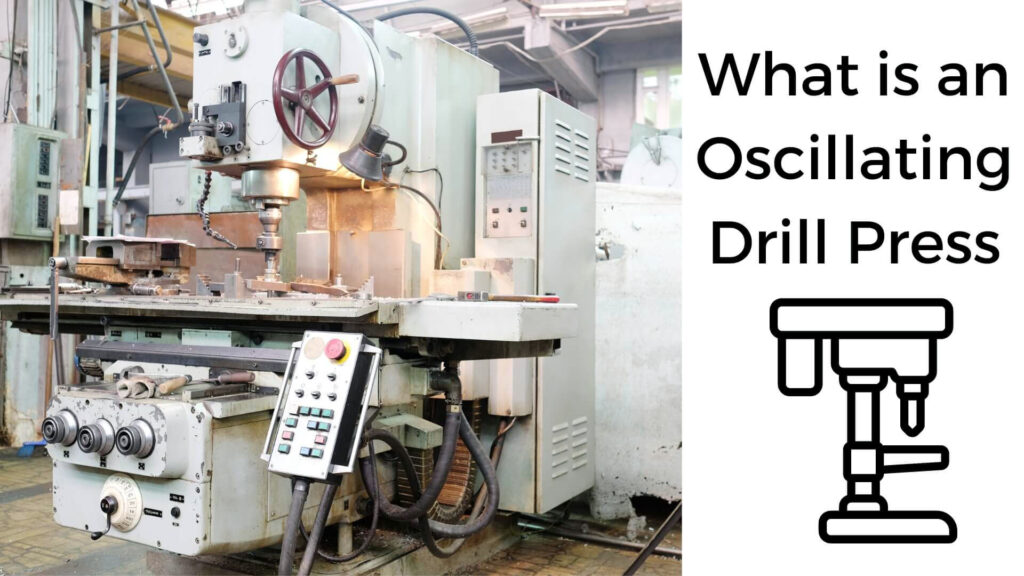An oscillating drill press is an innovative tool that combines traditional drilling with oscillation movement, allowing for enhanced precision and versatility in various applications. This powerful machine is particularly useful for woodworkers, metalworkers, and DIY enthusiasts who require intricate drilling capabilities.
In this blog post, I will explore the workings of an oscillating drill press, its components, advantages, types, features, and safe usage tips.
Table of Contents
How Does an Oscillating Drill Press Work?
An oscillating drill press operates on a dual-action mechanism that combines rotary drilling with an up-and-down oscillating motion. This unique approach allows for more precise cuts and drill holes, especially in materials that require careful handling or when creating intricate designs.
The Oscillation Mechanism
- Rotary Motion: The drill bit spins in the same way a traditional drill operates. This rotational motion is powered by an electric motor that drives the spindle.
- Oscillating Motion: In addition to spinning, the drill bit also moves vertically in a controlled up-and-down motion. This oscillation can often be adjusted in speed and stroke length, allowing the user to adapt to different materials and project requirements.
This combination of movements enables the oscillating drill press to:
- Create smoother holes with less splintering or chipping, particularly in softer materials like wood.
- Enhance the cutting action, making it easier to drill through harder materials without excessive force.
- Improve overall accuracy by reducing the chance of wandering or misalignment during the drilling process.
Advantages of Oscillation Compared to Traditional Drilling
Oscillating drill presses offer several advantages over traditional drill presses, making them a valuable addition to any workshop:
- Increased Precision: The oscillating motion helps to maintain a consistent contact with the material, resulting in cleaner and more accurate holes.
- Reduced Heat Build-up: The dual action of oscillation and rotation minimizes friction, which can lead to overheating of the drill bit and workpiece. This is especially important when drilling into dense materials.
- Versatility: Oscillating drill presses can be used for various tasks, including drilling, sanding, and contouring, providing more flexibility than a standard drill press.
- Less Chatter: The oscillation reduces the risk of tool chatter, a common issue in traditional drilling, leading to improved surface finish.
- Better Control: The oscillating motion gives operators better control over the drilling process, making it easier to perform detailed work without sacrificing accuracy.
Key Components of an Oscillating Drill Press and Their Functions
Understanding the key components of an oscillating drill press will help you appreciate its functionality and capabilities:
- Base: The sturdy foundation of the drill press that provides stability during operation. A wider base enhances the overall stability of the machine.
- Column: The vertical post that connects the base to the drill head. It provides support for the moving parts and houses the drive mechanism.
- Drill Head: This part houses the motor and the chuck that holds the drill bit. It also contains the oscillation mechanism that allows for the vertical movement.
- Chuck: The part that holds the drill bit securely in place. It can be easily adjusted or replaced, allowing for different sizes and types of drill bits.
- Oscillation Mechanism: The internal mechanism that controls the up-and-down motion of the drill bit. It consists of gears, levers, and other components that facilitate the oscillating action.
- Table: The flat surface where the workpiece is placed. Many oscillating drill presses come with adjustable tables, allowing users to tilt or raise the workpiece for various drilling angles.
- Power Switch: The on/off switch that controls the drill press operation. Safety features may include emergency stop buttons for quick shutoff.
- Feed Handle: The handle that allows the user to manually control the drilling depth and pressure applied to the workpiece.
Types of Oscillating Drill Presses
There are generally two main types of oscillating drill presses, each suited for different applications and environments.
Benchtop Oscillating Drill Press
Benchtop oscillating drill presses are compact, lightweight machines designed for smaller workshops or home use. They can be easily placed on a workbench, providing a stable platform for various drilling tasks.
Advantages:
- Space-Saving: Their compact size makes them ideal for small workshops or hobbyist use.
- Affordable: Generally less expensive than floor-mounted models, making them accessible to a wider audience.
- Ease of Use: Simple operation and setup, ideal for beginners.
Floor-mounted Oscillating Drill Press
Floor-mounted oscillating drill presses are larger, more powerful machines designed for heavy-duty use in professional or industrial settings. They typically offer greater stability and higher performance.
Advantages:
- Higher Power: More powerful motors enable faster drilling and the ability to work with tougher materials.
- Increased Stability: The floor-mounted design provides enhanced stability, reducing vibrations during operation.
- Greater Capacity: Larger tables and deeper drilling capabilities make them suitable for a wider range of projects.
Comparison of the Two Types in Terms of Size, Power, and Versatility
| Feature | Benchtop Oscillating Drill Press | Floor-mounted Oscillating Drill Press |
|---|---|---|
| Size | Compact, portable | Larger, more substantial |
| Power | Lower power (typically 1/2 HP) | Higher power (1 HP and above) |
| Versatility | Suitable for light to medium tasks | Ideal for heavy-duty applications |
| Price | More affordable | Generally higher cost |
| Stability | Good for small tasks | Excellent for larger, demanding jobs |
Key Features to Look for When Buying an Oscillating Drill Press
When purchasing an oscillating drill press, it’s essential to consider several features to ensure you select the right model for your needs:
- Power: Look for a machine with sufficient power to handle your intended tasks. A higher horsepower rating typically means more capability for tougher materials.
- Oscillation Stroke Length: Adjustable stroke length allows for customization based on the materials being drilled. Longer strokes provide more versatility.
- Variable Speed Control: A model with adjustable speed settings gives you the flexibility to adapt to different materials and project requirements.
- Table Size and Adjustability: A larger table provides more stability for the workpiece, while adjustable tables offer greater versatility for angled or tilted drilling.
- Build Quality: A sturdy construction ensures durability and reduces vibrations during operation, which is crucial for precision work.
- Ease of Use: Look for user-friendly features such as simple controls, easy bit changes, and accessible power switches.
- Safety Features: Emergency shut-off switches and guards are essential for safe operation, especially in a busy workshop.
How to Use an Oscillating Drill Press Safely and Effectively
Using an oscillating drill press safely and effectively involves following certain practices to maximize efficiency and minimize risks:
- Read the Manual: Always familiarize yourself with the manufacturer’s instructions and safety guidelines before operating the machine.
- Wear Safety Gear: Use safety goggles, gloves, and hearing protection while operating the drill press to protect against debris and noise.
- Secure the Workpiece: Ensure the workpiece is firmly clamped to the table to prevent movement during drilling. Use appropriate fixtures for larger pieces.
- Set Up Correctly: Adjust the table height, angle, and drill bit speed based on the specific requirements of your project.
- Maintain a Clean Workspace: Keep the area around the drill press clean and free of clutter to reduce the risk of accidents.
- Don’t Force the Drill: Allow the oscillating drill press to do the work; forcing the drill can damage the tool or workpiece and lead to injury.
- Regular Maintenance: Perform routine checks and maintenance to keep the drill press in optimal condition. Clean debris, lubricate moving parts, and check for wear.
Conclusion
An oscillating drill press is a versatile and powerful tool that provides enhanced precision and control for various drilling tasks. Understanding how it works, its advantages, key components, and safety practices will help you maximize its potential in your workshop. Whether you opt for a benchtop or floor-mounted model, investing in an oscillating drill press can significantly elevate your drilling capabilities, making it a valuable addition to your toolkit.

Hey, I am MD Hrithik Hossain, I’m a huge fan of DIY crafts. My workshop is where I spend most of my spare time, and I’m always working on some project. To that end, I’d like to share some of my knowledge and experience with you in power tools, woodworking, and other specialized materials fabrication.
I will guide you with genuine knowledge that can assist you with deciding whether a drill is appropriate according to your requirements or not. If you want to find the best drill and know which type of drill is most suited for your needs, then I can guide you with my expertise. My passion lies in helping others find the correct products they need at an affordable price.


